#Poposauroidea
Explore tagged Tumblr posts
Text
Benggwigwishingasuchus: The Fisher Crocodile
I once again come bearing news from the realm of Pseudosuchia. Yes, we got a new taxon. Benggwigwishingasuchus eremicarminis ("Fisherman Croc's desert song") is a new basal member of the poposauroidea, a clade you might have heard about before.
But first some more key notes. Benggwigwishingasuchus has been recovered from the Anisian Fossil Hill Member of the Favret Formation, located in the US State of Nevada. It is known from a decently complete skeleton that preserves much of the neck and torso, a decent chunk of the limbs but only small pieces of the skull.
Left: Press release artwork of Benggwigwishingasuchus looking across the Panthalassan Ocean (Jorge A. Gonzalez) Right: Fossil material

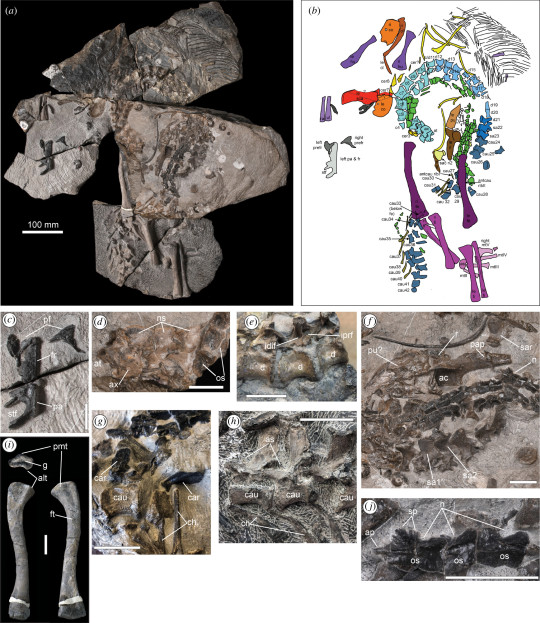
As said already, Benggwigwishingasuchus is considered a member of the poposauroidea, one of the most enigmatic groups of early pseudosuchians. The reason for that is that we primarily know them from their most derived members, the bipedal Poposaurus, the sail-backed ctenosauriscids, Lotosaurus, the ornithomimosaur-mimics of the Shuvosauridae and Qianosuchus. As you can see many appear kind of like proto-dinosaurs and most have lost their osteoderm armor, requiring a whole different skeletal structure to support their erect posture. But until recent years we knew little and less about where they came from. This is thankfully starting to change now, since we now not only have Benggwigwishingasuchus, but also Schultzsuchus (formerly "Prestosuchus" loricatus) described earlier this year, Mambawakale from two years ago and recently assigned to the group as well as Mandasuchus (similar to Mambawakale originally described as something else and recently considered as a basal poposauroid). Thanks to these we are slowly starting to see a transition. Schultzsuchus still has pretty standard armour for example, but Qianosuchus shows clear signs of reduction, with Benggwigwishingasuchus kinda falling into the middle between them.
Assorted Poposauroids: clockwise from top right: Poposaurus (Skye McDavid), Arizonasaurus (Gabriel Ugueto), Lotosaurus (Gabriel Ugueto), Shuvosaurus (Joschua Knüppe)
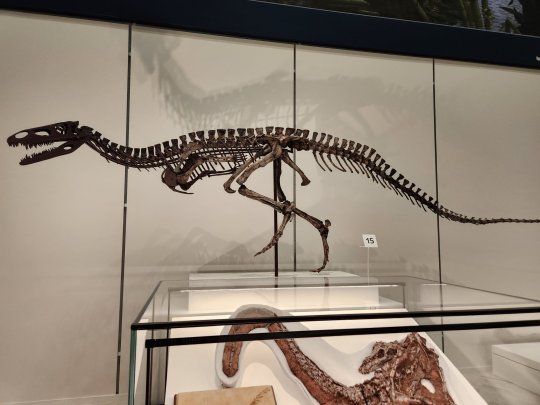



What's also interesting about Benggwigwishingasuchus is its ecology, or what little we can infer based on the circumstances of its preseration. You see, the Favret Formation preserves marine sediments and was previously best known for its ichthyosaurs (including the giant Cymbospondylus). So its kind of weird seeing a rather lanky pseudosuchian there. What's weirder still is the fact that the preservation seems to suggest that it wasn't swept out. No, its still reasonably complete, partially articulated and in the classic death pose with its back bent backwards, this thing was moved little before being burried. BUT. It wasn't marine. The skeleton fits of a terrestrial animal and both limb proportions and histology show no evidence of it being a swimmer or diver. Instead its hypothesized that it might have been an animal that inhabited the coast, possibly drawing sustenance from the sea but not actively adapted to forage in it. In this sense Benggwigwishingasuchus could parallel Ticinosuchus from Switzerland and Qianosuchus from China, both of which were coastal animals yet not explicitly aquatic (in the case of Qianosuchus it was originally proposed given its specialised tail, but recent work seems to suggest it was never very fast nor enduring).
Top image: Benggwigwishingasuchus standing on the skull of Cymbospondylus (Joschua Knüppe) Bottom left: Ticinosuchus among a group of Tanystropheus (Zach Robinson) Bottom right: Qianosuchus holding a fish (Gabriel Ugueto)



All in all, Benggwigwishingasuchus is an interesting animal that does fill in some gaps in the fossil record, both phylogentically and ecologically and though the description is sparce on actually describing the skeleton, here's hoping that more research will come out eventually. Hell, they dropped a histology on it like a day after it was named.
Wikipedia:
Benggwigwishingasuchus - Wikipedia Papers: A new pseudosuchian from the Favret Formation of Nevada reveals that archosauriforms occupied coastal regions globally during the Middle Triassic | Biology Letters (royalsocietypublishing.org)
Diverse growth rates in Triassic archosaurs—insights from a small terrestrial Middle Triassic pseudosuchian | The Science of Nature (springer.com)
#poposauroidea#benggwigwishingasuchus#favret formation#anisian#pseudosuchia#croc#prehistory#paleontology#palaeoblr#long post#paleontology news
103 notes
·
View notes
Text

Day 8: Lotosaurus
A sail-backed poposauroid known from Hunan Province of central China.
#my art#myart#paleoart#my drawings#lotosaurus#poposauroidea#pseudosuchia#archosaurs#triassic#middle triassic#toned tan#sketchbook#artists on tumblr
14 notes
·
View notes
Text

effigia morning warm up doodle
18 notes
·
View notes
Text
I ricercatori mappano l'albero genealogico dei coccodrilli per far luce sulla loro evoluzione
Poposaurus, da un gruppo di parenti estinti del coccodrillo noto come Poposauroidea. Questo coccodrillo era lungo circa quattro metri e visse accanto ai dinosauri da 237 a 201,3 milioni di anni fa. Un gruppo di ricerca, guidato da scienziati dell’Università di York, ha mappato l’albero genealogico dei feroci predatori dell’imboscata e dei loro parenti estinti noti come Pseudosuchia. Hanno poi…

View On WordPress
0 notes
Text
#SHUVOSAURID SWEEEP!!!#ik theyre not here i just love them. and also lagerpeptids i love them even more those poorly preserved little shits#seriously tho out of these options.#placodonts
Shuvosaurids are in Poposauroidea :)
A Triassic Weirdo is any organism or group of organisms that first appeared in the Triassic and last appeared in the Triassic, with no descendants reaching the Jurassic. As this period was preceded by a major mass extinction, and followed by a major mass extinction, this leads to a *lot* of very unique organisms for the time period.
209 notes
·
View notes
Text
It Came From The Wastebasket #15: Rauisuchian Revolution
Pseudosuchians, or "croc-line archosaurs", are one of the two major lineages of archosaur reptiles, alongside the avemetatarsalians (pterosaurs and dinosaurs). Although today they're represented only by crocodilians, they were especially successful and diverse back in the Triassic – and it was only after a mass extinction took out most of them that the dinosaurs were able to rise to prominence for the rest of the Mesozoic Era.
A grouping of pseudosuchians traditionally known as "rauisuchians" had upright limbs in a distinctive "pillar-erect" hip arrangement. Many of these croc-relatives were large quadrupedal predators, but others developed bipedal theropod-like postures, with some so remarkably convergent that they were initially misidentified as ornithomimosaurs.
The first rauisuchians were discovered in the 1930s, represented only by fragmentary remains, and while they were initially recognized as being pseudosuchians their exact evolutionary relationships within that group were poorly understood for a long time. Over the next several decades they were classified with aetosaurs (early armored pseudosuchians), then ornithosuchids (even earlier pseudosuchians), and then erythrosuchids (not even pseudosuchians but an earlier type of archosauriform).
More complete fossil discoveries and better cladistic analysis methods in the 1980s led to them being classified as being very closely related to crocodylomorphs, with three main lineages recognized: the prestosuchids, the rauisuchids, and the poposauroids.
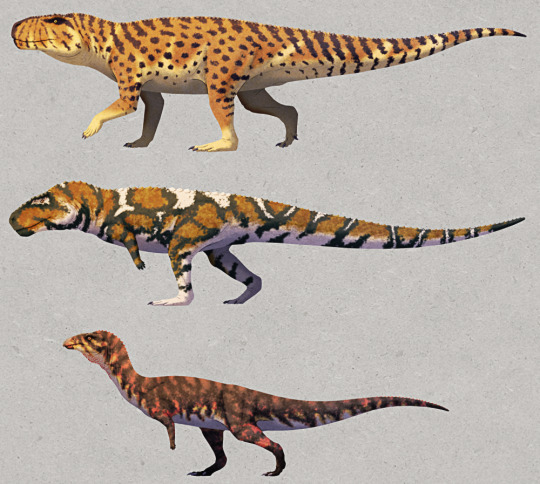
The "prestosuchid" Prestosuchus chiniquensis, the rauisuchid Postosuchus kirkpatricki, & the poposauroid Effigia okeeffeae (not to scale)
But even by the end of the 20th century "Rauisuchia" had never actually gotten a formal definition, and it had very much become a wastebasket taxon for a variety of paracrocodylomorph pseudosuchians that didn't easily fit into any other major lineages.
In the 2000s renewed interest in rauisuchians' anatomy and evolutionary relationships led to increasing recognition that they weren't even a single defined group, with various species instead falling into different points along an "evolutionary grade". The poposauroids and rauisuchids still seem to be distinct lineages, but the "prestosuchids" were found to be polyphyletic, with some forming a grade between the other two "rauisuchid" groups and others turning out to not even be paracrocodylomorphs.
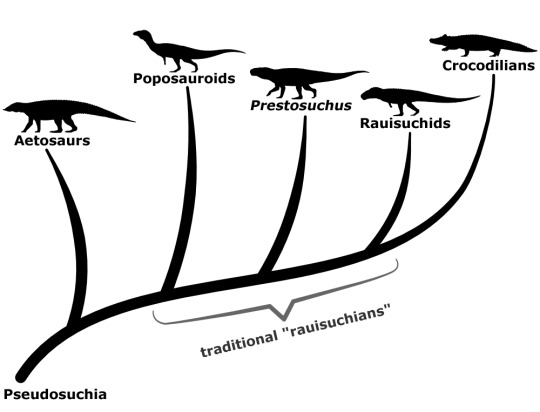
And although the taxonomic concept of "Rauisuchia" as a distinct group has now been abandoned, the term "rauisuchians" does still remain in common use as an informal name for these animals – probably because it's much more concise than saying "non-crocodylomorph paracrocodylomorphs".
———
Nix Illustration | Tumblr | Twitter | Patreon
#it came from the wastebasket#wastebasket taxon#taxonomy#rauisuchia#prestosuchus#prestosuchidae#postosuchus#rauisuchidae#effigia#poposauroidea#pseudosuchia#croc-line archosaurs#paleontology#art#science illustration#paleoart#palaeoblr
307 notes
·
View notes
Photo

Day 20: Arizonasaurus babbitti
#Arizonasaurus babbitti#Arizonasaurus#Ctenosauriscidae#Poposauroidea#Paracrocodylomorpha#Pseudosuchia#paleoart#paleoblr#palaeoblr#paleontology#archovember#archovember2022#dinovember#dinovember2022#art#digital art
39 notes
·
View notes
Text

Archovember Day 20: Poposaurus gracilis
Poposaurus gracilis is the type species for the clade Poposauroidea, a group of unusual pseudosuchians who tried all sorts of things, such as sail-backs, beaks, aquatic life, and in Poposaurus gracilis’ case: bipedalism.
Similar to a theropod dinosaur, Poposaurus had reduced front limbs and walked only on its hind limbs. It was fairly large, about 13 feet long… though half of that was its abnormally long tail. It would have walked with a very horizontal posture (though I have illustrated this one as rearing up to look around.) It was a carnivore living in the late Triassic of the southwestern USA.
Since its discovery in 1904, Poposaurus has been classified in nearly every group of archosaur. At first it was assumed to be a phytosaur. Some classified it as an ornithiscian dinosaur, some as a sauropodomorph, one paleontologist even considered it an early stegosaur! In 1961 it was classified as a theropod, particularly a Carnosaur, and then in 1977 it was finally placed within pseudosuchia. In 1995, 2007, and 2011, new Poposaurus fossils were discovered that confirmed this and further narrowed down where it belonged on the pseudosuchian tree.
#my art#Poposaurus#Poposaurus gracilis#poposaurids#pseudosuchians#archosaurs#archosauromorphs#Archovember#Archovember 2021#Draw Dinovember#Draw Dinovember 2021#Dinovember#Dinovember 2021#SaritaDrawsPalaeo
30 notes
·
View notes
Text
Lotosaurus adentus

(Image: Lotosaurus, a rotund, beaked reptile with a tall, arched back. It is attractively coloured in shades of grey, tan, and purple, runs on clean eco-friendly plants, and has optional internal heating. Image by Tas Dixon.)
Etymology: Toothless Lotus Lizard (after Hunan Province, the “Lotus State”)
First Described By: Fa-kui Zhang in 1975
Classification: Biota, Archaea, Proteoarchaeota, Asgardarchaeota, Eukaryota, Neokaryota, Scotokaryota, Opimoda, Podiata, Amorphea, Obazoa, Opisthokonta, Holozoa, Filozoa, Choanozoa, Animalia, Eumetazoa, Parahoxozoa, Bilateria, Nephrozoa, Deuterostomia, Chordata, Olfactores, Vertebrata, Craniata, Gnathostomata, Eugnathostomata, Osteichthyes, Sarcopterygii, Rhipidistia, Tetrapodomorpha, Eotetrapodiformes, Elpistostegalia, Stegocephalia, Tetrapoda, Reptiliomorpha, Amniota, Sauropsida, Eureptilia, Romeriida, Diapsida, Neodiapsida, Sauria, Archosauromorpha, Crocopoda, Archosauriformes, Eucrocopoda, Crurotarsi, Archosauria, Pseudosuchia, Suchia, Paracrocodylomorpha, Poposauroidea
Time and Place: Lotosaurus lived about 238 million years ago, in the Ladinian of the Middle Triassic.

Lotosaurus remains were found in the Badong formation, in Hunan Province of central China.

Physical Description: Lotosaurus was a croc-line archosaur with especially high neural spines, and sort of resembled a plate-less stegosaur—a very naked stegosaur, indeed. It had far longer legs and a more erect stance than any of today’s crocodilians, meaning that it would have carried its body further off the ground. This is needed, as its arching ribs gave it a fairly large barrel-shaped gut. From nose to tail tip, the animal reached about 1.5-2.5m in length.
Traditionally Lotosaurus has been restored with a sail, in the manner of Dimetrodon or Spinosaurus. Is this the case? I’m not sure that it was. The neural spines, though tall, are certainly not ridiculously so—more within the range of Acrocanthosaurus, a dinosaur that is more commonly restored with a hump. This may indeed have been the case with Lotosaurus, though this idea has not been tested.
It’s unclear whether Lotosaurus was warm-blooded, cold-blooded, or somewhere in-between, but some evidence has suggested that the ancestors of croc-line archosaurs might have been warm-blooded or “lukewarm-blooded”. If this is the case, and Lotosaurus had a fast metabolism, it might be beneficial for it to store a lot of fat in the form of a hump. On the other hand, if it were warm-blooded and produced its own body heat, it might have the issue of needing to get rid of excess body heat so as to not overheat, and so a sail may have been more useful. And if it were cold-blooded, the increased surface area might have helped it absorb more sun on a cold day.
Lotosaurus is of special note due to its toothless, beaked mouth, a far cry from the toothy grins of today’s crocodiles. This is actually not uncommon among fossil croc relatives, however; the armoured Stegonolepis and its aetosaur friends had toothless beaks to the front of their mouths, and the bipedal, fast-running shuvosaurids were entirely toothless. As a poposauroid, Lotosaurus was a relative of this latter group; however, it is unknown whether they inherited their beaks from a common ancestor or evolved them independently.
Some of this difficulty stems from the fact that we don’t really have anything else that’s much like Lotosaurus. It’s kind of unique out there in the world of croc-line palaeontology. Other poposauroids had toothless beaks, but these were slender, long-necked bipeds; other poposauroids had tall neural spines, but these had larger heads with fiercely toothed jaws. Lotosaurus stands alone as an odd mishmash of body plans, a weirdo doing its own thing in a world populated by other weirdos.
Diet: Having a toothless beak, much like having a pair of scissors, a hedge-clipper, or a diesel chainsaw, is great if you want to cut down a lot of plants, and that’s likely what it did with them. Lacking teeth, it probably swallowed these plants whole.
Plants are hard to digest. That’s because they have a lot of cellulose in them, to give them structure, and no animal has evolved an enzyme to break cellulose down. The solution to this, found by herbivores again and again throughout Earth history, is to stew food in the gut for a long time. This allows the gut flora—AKA the little microscopic friends who live in your digestive tract—to do the digesting for them. Having more time for digestion means more time for nutrient extraction, and the best way to increase time in the gut is to have a bigger gut (This also means that they can eat more food now and worry about digesting it later). None of this is necessary for digesting meat. This is why, if you look at a cow or an elephant, they tend to have round, fat torsos, while cats tend to be much skinnier. Unless it’s my cat, who is as chubby as any self-respecting herbivore.
Back to Lotosaurus. Having no teeth, it lost out on the oral processing aspect of digestion that is taken to extremes by many mammals, but it made up for this with gut residency. Much like many herbivorous dinosaurs, it’s likely that Lotosaurus ate large amounts of plants without chewing, and relied on its guts to do the heavy lifting.
Behavior: Lotosaurus has been found in bonebeds of dozens of individuals, aged juvenile through adult. Not all remains were articulated, though many were; the bones also show only minimal signs of weathering and no tooth marks from predators or scavengers. Taken together, these facts suggest that the animals likely died together, spent some short time on the surface, and were then catastrophically buried together. The rocks also preserve fossil mudcracks, and the area is interpreted as a floodplain pond.
What exactly this means for the ecology of the animal is open to some interpretation. It is possible that Lotosaurus lived in herds, and that this herd died together during a drought; however, it is equally possible that Lotosaurus lived a solitary life, and that these individuals were drawn together by a dwindling pond during the dry season, only to perish when the pond dried up.
Very little has been written about the actual ecology of Lotosaurus. At a glance it appears to have been perfectly competent on land, though I see nothing in its anatomy to suggest it would not have been an adequate swimmer if need be.
Ecosystem: The Triassic was, for the most part, characterised by being hot and dry due to the supercontinent Pangaea forming a vast interior desert. However, around this time, China was not part of Pangaea, but rather a bunch of large, Greenland-sized islands waiting to be schmammed onto Pangaea. It thus seems that Lotosaurus was an island taxon, albeit a very large island.
What was that island like? The rocks in which Lotosaurus fossils are found are interpreted as being deposited in a dried-out lake in a floodplain; whether they lived in the lake or simply relied upon it for drinking water is unknown. The bonebed from which all certain Lotosaurus fossils were retrieved also contains the isolated teeth of a temnospondyl amphibian and a carnivorous archosauriform, indicating that these animals were also present in their ecosystem.
From the types of clay present in the Lotosaurus site, we can tell that the climate experienced medium-to-high chemical weathering with moderate rainfall; development of fossil soils (palaeosols) and presence of certain invertebrates indicate that a dry season-wet season pattern occurred. This is consistent with the interpretation of the bonebed as having been formed by animals who died from drought and later covered, ironically, by floodwaters.
–By Hayley Orlowski
Sources Under the Cut
Hagen, C. J., Roberts, E. M., Sullivan, C., Liu, J., Wang, Y., Owusu Agyemang, P. C., & Xu, X. (2018). Taphonomy, Geological Age, and Paleobiogeography of Lotosaurus adentus (archosauria: Poposauroidea) from the Middle-Upper Triassic Badong Formation, Hunan, China. Palaios, 33(3), 106-124.
FA-KUI, ZHANG. (1975). A NEW THECODONT LOTOSAURUS, FROM MIDDLE TRIASSIC OF HUNAN.
Legendre, L. J., Guénard, G., Botha-Brink, J., & Cubo, J. (2016). Palaeohistological evidence for ancestral high metabolic rate in archosaurs. Systematic Biology, 65(6), 989-996.
#lotosaurus#lotosaurus adentus#poposaurid#pseudosuchian#triassic#triassic madness#triassic march madness#prehistoric life#paleontology
251 notes
·
View notes
Text
Cá sấu tiền sử và một số loài khác

Megalampris Loài cá mặt trăng khổng lồ Megalampris keyesi từng tồn tại vào cuối thế Oligocen (26 triệu năm trước) ở vùng biển new zealand ngày nay, và chúng to gấp đôi loài cá mặt trăng hiện đại. Tổng chiều dài của chúng tính từ đầu đến đuôi là gần 4m và khoảng cách từ vây này tới vây kia của chúng là hơn 3m. Trong khi các chỉ số này của loài cá mặt trăng ngày nay lần lượt chỉ là 2m và 1,5m. Không giống các loài hậu duệ thường chỉ có màu trắng đục, loài Megalampris có vây màu đỏ và cơ thể màu xanh biển, con mồi của chúng bao gồm các loài cá , mực nhỏ , nhưng đồng thời chúng cũng là một món ăn trong thực đơn của các loài cá mập Carcharocles và cái voi Waipatia cổ đại.

Anatosuchus Sống ở kỷ Creta sớm, thuộc lớp Notosuchia , chiều dài khoảng 70cm, hoá thạch được tìm thấy ở Niger. Tên của nó xuất phát từ tiếng Latinh anas ("vịt") và souchos trong tiếng Hy Lạp ("cá sấu"), nghĩa là mõm rộng giống vịt) là một chi đã tuyệt chủng của loài cá sấu notosuchian được phát hiện ở Gadoufaoua, Niger, và được mô tả bởi một nhóm các nhà cổ sinh vật học do Paul Sereno người Mỹ dẫn đầu vào năm 2003, trên Tạp chí Cổ sinh vật học có xương sống. Mõm giống vịt của nó tình cờ khiến nó giống cá sấu, một loài động vật lai được tưởng tượng với đầu của cá sấu và thân của vịt

Simosuchus Tên của nó có nghĩa là "cá sấu mũi gồ" trong tiếng Hy Lạp, là một chi cá sấu notosuchian đã tuyệt chủng từ kỷ Creta muộn của Madagascar. Nó được đặt tên cho hộp sọ ngắn bất thường của nó. Các cá thể trưởng thành hoàn toàn có chiều dài khoảng 0,75 m. Loài này là Simosuchus clarki, được tìm thấy từ Hệ tầng Maevarano ở tỉnh Mahajanga, mặc dù một số hóa thạch đã được tìm thấy ở Ấn Độ. Răng của S. clarki có hình dạng giống như những chiếc lá phong, cùng với chiếc mõm ngắn và sâu cho thấy nó không phải là động vật ăn thịt như hầu hết các loài crocodylomorph khác. Trên thực tế, những đặc điểm này đã khiến nhiều nhà cổ sinh vật học coi nó là một loài động vật ăn cỏ.

Protosuchus là một chi crocodylomorph ăn thịt đã tuyệt chủng từ đầu kỷ Jura. Cái tên Protosuchus có nghĩa là "con cá sấu đầu tiên", và là một trong những loài động vật giống cá sấu sớm nhất. Protosuchus dài khoảng 1m và nặng khoảng 40kg. Là một họ hàng đầu tiên của cá sấu, hộp sọ của nó có nhiều đặc điểm của loài cá sấu hơn tổ tiên trước đó của nó, nó có bộ hàm ngắn mở rộng ra ở đáy hộp sọ, cung cấp một bề mặt lớn để các cơ hàm của nó có thể bám vào. Điều này làm tăng độ dài tối đa của miệng con vật và lực mà hàm có thể đóng lại. Hàm răng của con vật này cũng giống cá sấu hiện đại, bao gồm cả răng ở hàm dưới gắn thành các rãnh ở hai bên hàm trên khi miệng đóng lại. Nó cũng sở hữu một chiếc đuôi mạnh mẽ mà sau này được phát triển thành cơ chế đẩy nước trong thế hệ con cháu của nó. Cơ thể được bao phủ và củng cố bởi các bộ xương thành một hàng đôi dọc theo lưng và bao phủ phần dưới của cơ thể và toàn bộ phần đuôi. Đó là một loài bò sát bốn chân khác thường có chân dạng cột, với chân sau dài hơn chân trước. Năm ngón chân của nó có móng vuốt và người ta tin rằng chúng là những loài chạy giỏi và bơi giỏi.

Armadillosuchus là một chi sphagesaurid crocodylomorph đã tuyệt chủng. Sống ở kỷ Creta muộn và hoá thạch được tìm thấy ở lưu vực Bauru ở Brazil, có niên đại khoảng 70 triệu năm. Chiều dài của Armadillosuchus được ước tính trên 2m với khối lượng cơ thể ước tính là 120kg. Armadillosuchus đặc biệt giống động vật có vú ở chỗ nó có bộ giáp nặng nề đặc trưng bởi các dải linh hoạt và những tấm khiên cứng che phía sau lưng, ít giống với bộ xương truyền thống dùng để lót lưng của hầu hết các loài crurotarsan và giống như của armadillo hiện đại (do đó tên chi nghĩa là "cá sấu armadillo") hoặc một glyptodont. Bởi vì hình thái độc đáo của nó, nó được cho là đã có lối sống trên cạn.

Hoá thạch Armadillosuchus

Lotosaurus Lotosaurus là một chi đã tuyệt chủng thuộc lớp Poposauroidea sống ở Trung Quốc thuộc kỷ Trias khoảng 245-237 triệu năm trước. Nó dài 2,5 m và là một loài động vật ăn cỏ, cắn đứt lá bằng bộ hàm không răng. Lotosaurus có một cánh buồm trên lưng. Nó trông tương tự như các loài pelycosaurs kỷ Permi như Dimetrodon và Edaphosaurus, mặc dù không cao bằng. Có thể cánh buồm trên lưng đã sử dụng để trang trí hoặc điều chỉnh nhiệt độ cơ thể. Lotosaurus lần đầu tiên được đặt tên bởi Fa-kui Zhang vào năm 1975 và loài này là Lotosaurus adentus. Lotosaurus ban đầu được đặt trong họ riêng của nó, Lotosauridae, được Zhang đặt tên vào năm 1975. Tên cụ thể có nguồn gốc từ tiếng Hy Lạp : “ a và denta “ có nghĩa là "không răng", liên quan đến chiếc mỏ không răng của nó.

Shuvosaurus Tên của nó có nghĩa là "thằn lằn của Shuvo" , thuộc lớp Poposauroidea , chiều dài khoảng 2m, là một chi bò sát có mỏ thuộc kỷ Trias muộn của Texas. Nó được mô tả bởi Sankar Chatterjee vào năm 1993 sau khi nó được phát hiện bởi con trai ông Shuvo. Ban đầu nó được hiểu là thành viên kỷ Trias của họ khủng long kỷ Phấn trắng Ornithomimidae. Tuy nhiên, phát hiện gần đây về loài Effigia có liên quan từ Ghost Ranch cho thấy Shuvosaurus có quan hệ họ hàng gần hơn với cá sấu, và những điểm tương đồng giữa loài vật này và ornithomimids là kết quả của quá trình tiến hóa hội tụ

Arizonasaurus Tên của nó có nghĩa là thằn lằn Arizona, chiều dài khoảng 3m, là một chi archosauria của họ Ctenosauriscidae sống vào thời kỳ Trung Trias (243 triệu năm trước). Nó có liên quan mật thiết với cá sấu, và gần giống với loài khủng long Spinosaurus. Arizonasaurus được tìm thấy trong Hệ tầng Moenkopi Trias giữa ở phía bắc Arizona. Một bộ xương khá hoàn chỉnh được tìm thấy vào năm 2002 bởi Sterling Nesbitt. Nó có lưng buồm lớn được hình thành bởi các gai thần kinh dài của các đốt sống. Loài này được đặt tên bởi nhà cổ sinh vật học Samuel Paul Welles vào năm 1947.

Poposaurus là một chi pseudosuchian archosaur đã tuyệt chủng từ kỷ Trias muộn ở Tây Nam Hoa Kỳ. Chiều dài khoảng 5m, nó thuộc chi Poposauroidea, một nhóm thường bao gồm các loài có sống lưng bằng buồm, có mỏ và sống dưới nước. Hóa thạch đã được tìm thấy ở Wyoming, Utah, Arizona và Texas. Ngoại trừ hộp sọ, hầu hết các bộ phận của bộ xương đều được biết đến. Kể từ khi nó được mô tả lần đầu tiên, Poposaurus đã được phân loại khác nhau như một loài khủng long. Giống như khủng long chân đốt, Poposaurus là loài di chuyển bằng hai chân thay vì bốn chân. Tuy nhiên, với tư cách là một pseudosuchian, nó có quan hệ gần gũi với cá sấu sống dưới nước hơn là khủng long. Poposaurus được cho là đã tiến hóa hình thức vận động này một cách độc lập, có thể là do khả năng đi bộ cao của archosaurs ban đầu.

Kaprosuchus Theo tiếng Hy Lạp tên của nó có nghĩa là “ cá sấu heo rừng" , là một chi cá sấu lớn mahajangasuchid từ giai đoạn Aptian Niger , thuộc kỷ Creta muộn. Nó được biết đến từ một hộp sọ gần như hoàn chỉnh. Nó được đặt tên từ những chiếc răng hình răng nanh lớn bất thường hơi giống với những chiếc răng của lợn rừng. Kaprosuchus được ước tính phát triển đến chiều dài khoảng 6m. Nó sở hữu ba bộ răng hình nanh lớn nhô ra trên và dưới hộp sọ của nó, một trong số đó ở hàm dưới phù hợp với các vết khía ở hàm trên. Nếu không có những vết khía này thì hàm của nó đã được giữ lại vĩnh viễn bởi chính răng của nó. Điều này đã không được nhìn thấy trong bất kỳ crocodyliform nào khác. Kaprosuchus có một đặc điểm khác là sừng lớn hình thảm được làm từ xương niêm mạc và xương đỉnh nhô ra phía sau phía trên hộp sọ. Điều này cũng đã được nhìn thấy là họ hàng nhỏ hơn của nó Mahajangasuchus, làm cho nó rất khác với hầu hết các loài crocodyliforms khác. Nó có thể đã đối đầu với loài ăn thịt lớn, cụ thể là Spinosaurus non khi chúng cố gắng uống nước gần một hồ nước. Nó cũng ăn những con khủng long con. Nó là một thợ săn hung dữ và sẽ tấn công con mồi một cách man rợ, xé nát chúng bằng những chiếc răng giống như con lợn rừng. Sinh vật này sẽ là một kẻ săn mồi tích cực, săn đuổi con mồi của nó, đó là lý do tại sao một số người gọi chi này là '' mèo răng kiếm mặc áo giáp ''. Không giống như cá sấu hiện đại. Sinh vật này sẽ đi bằng hai chân thẳng để tiết kiệm năng lượng và giúp việc đi lại dễ dàng nhìn thấy hơn vì đây là một sinh vật chủ yếu sống trên cạn. Kaprosuchus có thể là một trong những kẻ săn mồi hàng đầu trong môi trường sống của nó vì nó nhanh nhẹn, có giáp và có vết cắn tàn khốc. Nó sẽ không khác với những con hổ ngày nay khi nhìn thấy sư tử săn trong bầy và không có bằng chứng những sinh vật này bị săn trong bầy. Nếu chúng thực sự đi săn theo bầy thì chúng đã có thể hạ gục hầu hết các con mồi trong khu vực của nó và chỉ để dành lại những loài ăn thịt lớn nhất và động vật ăn cỏ lớn. Kaprosuchus hẳn đã có thị lực tốt vì nó có đôi mắt hướng về phía trước trên đỉnh đầu. Điều này có thể mang lại cho nó tầm nhìn hai mắt và mức độ nhận biết chiều sâu. Được ví như những con cá sấu hiện đại và những con mèo lớn sống trên cạn, nó có tầm nhìn ban đêm tuyệt vời và cũng là những kẻ săn mồi về đêm. Điều này có nghĩa là Kaprosuchus cũng là một thợ săn đêm ở một mức độ nào đó. Điều này sẽ có lợi vì tất cả sự cạnh tranh từ các loài ăn thịt lớn khác sẽ giảm đáng kể và mang lại cho nó nhiều cơ hội để giết con mồi hơn.

Hoá thạch Kaprosuchus

Dakosaurus là một chi crocodylomorph đã tuyệt chủng trong họ Metriorhynchidae sống trong kỷ Jura muộn và kỷ Phấn trắng sớm. Được mệnh danh là “ cá sấu của đại dương “. Nó có kích thước khá lớn khoảng 4-5m, với những chiếc răng có răng cưa và nén về phía mặt (dẹt từ bên này sang bên kia). Chi này được Friedrich August von Quenstedt phát hiện vào năm 1856, ở Mexico, Argentina. Dakosaurus là một loài động vật ăn thịt đã trải qua hầu hết cuộc sống ở dưới biển, nhưng vì không có trứng hoặc tổ nào được phát hiện nên cho dù nó đã sinh ra để sống trên biển như cá heo và ichthyosaurs, hoặc lên bờ như rùa thì không biết. Cái tên Dakosaurus có nghĩa là "thằn lằn biter", và có nguồn gốc từ tiếng Hy Lạp dakos ("biter") và σαῦρος -sauros ("thằn lằn").

Hoá thạch Dakosaurus

Smilosuchus là một loài bò sát phytosaurid phytosaurian từ kỷ Trias muộn của Hoa Kỳ. Nó được đặt tên chính thức vào năm 1995 bởi R. A. Long và P. A. Murry. Nó là một trong những loài phytosaurs lớn đã từng tồn tại ( kích thước khoảng 5m). Smilosuchus giống cá sấu, với thân hình đồ sộ, 4 chân bán dựng đứng, đuôi dài, vạm vỡ, đầu lớn với bộ hàm đồ sộ và đôi mắt trên đỉnh đầu. Tuy nhiên, nó có một vài điểm khác biệt lớn, chẳng hạn như lỗ mũi nằm gần mắt, mõm hơi hếch và răng cưa. Thậm chí có một số khác biệt giữa các loài, vì Smilosuchus gregorii có mõm sâu và rộng hơn và răng to giống như răng nanh, trong khi Smilosuchus adamanensis có mõm nông hơn và mỏng hơn và răng nhỏ, hình nón. Cơ thể của nó được bao phủ bởi lớp da có vảy, với một hàng bộ xương chạy dọc lưng và đuôi. Smilosuchus là một kẻ săn mồi, chế độ ăn cụ thể phụ thuộc vào loài. Do có mõm sâu hơn và hàm răng chắc khỏe hơn, loài S.gregorii nói trên có thể đã săn các loài khủng long nhỏ, loài chim cỡ vừa và lớn. Mặt khác, loài S.adamanensis nói trên sẽ săn mồi bằng cách sử dụng những chiếc răng nhỏ, mỏng và chiếc mõm mảnh mai của nó để bắt chúng. Smilosuchus có lối sống vừa dưới nước và trên cạn. Mặc dù cá sấu có xu hướng dành 50% thời gian ở dưới nước, nó cũng là một loài động vật trên cạn có năng lực và có thể thực hiện "bước đi trên cao" tương tự như cá sấu hiện đại. Tuy nhiên, không giống như cá sấu hiện đại, răng của nó có hình răng cưa, và có thể xẻ thịt những con mồi. Do nó không thực hiện được động tác xoay tròn mà cá sấu hiện đại có thể làm khi xé xác con mồi, và có thể nó đã sử dụng một kiểu chuyển động khác để xé toạc thức ăn của nó. Do có răng to và mõm sâu, nó sẽ thích săn các động vật thủy sinh nhỏ. Smilosuchus mới nở sẽ phải tự chống đỡ, có thể ẩn náu trong thảm thực vật để trốn những kẻ săn mồi như loài lưỡng cư lớn Anaschisma, loài khủng long nhỏ Coelophysis, Poposaurus và Postosuchus.

Hoá thạch Smilosuchus

Boverisuchus là một chi đã tuyệt chủng của crocodylian planocraniid được biết đến từ Eocen giữa (giai đoạn Lutetian) của Đức và tây Bắc Mỹ. Nó đã phát triển chiều dài khoảng 3m. Loài Boverisuchus lần đầu tiên được đặt tên bởi nhà cổ sinh vật học Oskar Kuhn vào năm 1938. Dựa trên các mẫu hoá thạch khác, Boverisuchus được cho là có lớp da bọc thép dày và các chi dài gợi ý đến một thói quen (tức là chạy). Nó cũng có những ngón chân giống móng guốc, cho thấy rằng nó sống trên cạn nhiều hơn là dưới nước, và do đó nó có thể săn các loài động vật có vú trên cạn. Răng của Boverisuchus bị nén về bên, sắc nhọn và có các cạnh răng cưa. Do sự giống nhau của chúng với một số loài khủng long chân đốt nhất định, ban đầu chúng bị nhầm với răng của loài chân đốt, khiến các nhà cổ sinh vật học tin rằng một số loài khủng long không phải chim đã sống sót sau sự kiện tuyệt chủng kỷ Creta – Paleogen. Đuôi gợi nhớ nhiều hơn đến khủng long, có mặt cắt ngang và không có mào biểu bì xương được quan sát thấy ở các loài cá sấu còn tồn tại

Desmatosuchus là một chi archosaur đã tuyệt chủng thuộc Bộ Aetosauria. Nó sống trong kỷ Trias muộn. Desmatosuchus là một loài bò sát bốn chân lớn có chiều dài lên tới 4,5 mét. Cột sống của nó có 3 đốt sống xương cùng. Đặc điểm giải phẫu khác biệt nhất của loài archosaur này là xương vảy của nó sở hữu các quá trình chuyển động lớn thường được gọi là "gai vai". Các chi trước ngắn hơn nhiều so với chi sau. Khung chậu bao gồm một xương mu dài, các xương đùi tương đối dài và thẳng, cổ chân hình vòng kiềng, với các củ xương đùi giúp nó có gót chân lớn. Hộp sọ của nó tương đối nhỏ, dài trung bình khoảng 37cm, rộng 18cm và cao 15cm. Các cá thể của Desmatosuchus được mặc giáp dày. Lớp vỏ được tạo thành từ hai hàng rãnh giữa được bao quanh bởi hai hàng rãnh bên nữa. Các rãnh bên có các quá trình giống như gai phát triển tốt, hướng ra bên và phía sau. Thường có năm hàng gai, tăng kích thước về phía trước. Cột sống phía trước lớn hơn nhiều, dài khoảng 28cm, chúng đã phát triển phong phú trong kỷ Trias muộn. Có thể là Desmatosuchus đi theo bầy đàn hoặc đơn vị gia đình. Điều này được chứng minh bằng một số phát hiện về nhiều bộ xương Desmatosuchus ở những khu vực tương đối nhỏ. Desmatosuchus có hàm răng cùn, điều này kết hợp với cái xẻng giống như mõm của nó, cho thấy rằng Desmatosuchus kiếm ăn bằng cách đào lên các thảm thực vật mềm. Phương pháp cho ăn này còn được chứng minh bằng việc nó không có răng trước và đầu răng giả được bao phủ trong lớp vỏ sừng. Những lớp vỏ bọc này bảo vệ xương và có thể được sử dụng để cắt hoặc giữ thức ăn. Người ta tin rằng Desmatosuchus đào kiếm thức ăn trong bùn mềm gần các vùng nước do sự phong phú của các hồ và sông và thực tế là xương của Desmatosuchus thường được tìm thấy trong hoá thạch của các loài bò sát khác được biết là đã kiếm ăn dọc theo các bờ sông. Người ta không biết liệu Desmatosuchus có thay răng của chúng hay không và nếu có thì làm thế nào. Số lượng thấp răng Desmatosuchus được phát hiện cho thấy chúng chỉ được giữ cố định bằng các kết nối mô mềm. Bộ giáp và gai của Desmatosuchus là cách duy nhất để tự vệ khỏi những kẻ săn mồi. Các hàng gai bên cho thấy sự thay đổi về kích thước giữa các cá thể, đặc biệt là hàng gai thứ hai ở phía trước. Ngoài bộ giáp này, Desmatosuchus không có khả năng tự vệ nào khác trước các cuộc tấn công từ động vật ăn thịt. Một số bộ xương của Desmatosuchus đã được tìm thấy trong số các bộ xương của Postosuchus. Bản chất bầy đàn của Desmatosuchus dường như không làm nản lòng những kẻ săn mồi, vì Postosuchus cùng với một số loài ăn thịt kỷ Trias muộn khác cũng đi theo nhóm. Hầu hết các loài cá sấu thuộc kỷ Trias muộn đều thiếu một số đặc điểm vùng chậu nhất định hỗ trợ sự vận động. Desmatosuchus sở hữu đặc điểm này, cùng với xương đùi dài và mu dài, khiến nó trở nên cơ động hơn hầu hết các loài cá sấu cùng thời. Khả năng di chuyển này cùng với kích thước, sự phong phú và chiếc mỏ chuyên biệt đã khiến nó trở thành loài động vật ăn cỏ chính trong thời kỳ Trias

Postosuchus là một chi bò sát rauisuchid đã tuyệt chủng bao gồm hai loài P. kirkpatricki và P. alisonae, sống ở khu vực ngày nay là Bắc Mỹ trong kỷ Trias muộn. Tên của nó đề cập đến Post Quarry, một nơi ở Texas, nơi nhiều hóa thạch của loài P. kirkpatricki, được tìm thấy. Nó là một trong những kẻ săn mồi đỉnh cao trong khu vực của nó trong kỷ Trias, nó có kích thước lớn hơn những khủng long nhỏ săn mồi cùng thời (chẳng hạn như Coelophysis). Nó là một thợ săn có thể săn những động vật ăn cỏ to lớn cồng kềnh như động vật có gai và nhiều sinh vật khác nhỏ hơn chính nó (chẳng hạn như khủng long sơ khai). Tình trạng cực ngắn của chi trước so với chi sau, bàn tay rất nhỏ và số đo các đốt sống cho thấy Postosuchus có thể đã vận động bằng hai chân. Postosuchus là một trong những loài bò sát ăn thịt lớn nhất vào cuối kỷ Trias. Con trưởng thành có chiều cao khoảng 1,2m , chiều dài 4m, từ mõm đến đầu đuôi và khối lượng của chúng có thể dao động từ 250 đến 300kg. Nó có một hộp sọ được xây dựng khổng lồ mang những chiếc răng giống như dao găm. Cổ thon dài, mở rộng đến thân ngắn và đuôi dài. Cùng với phần còn lại của bộ xương, các nhà cổ sinh vật học cũng xác định các bộ xương, là những mảng dày tạo thành vảy. Chúng nằm trên lưng, cổ, và có thể ở trên hoặc dưới đuôi. Postosuchus sống trong môi trường nhiệt đới. Khu vực ẩm và ấm bao gồm các loài dương xỉ, các cây hạt trần. Postosuchus sống ở vùng cao cùng với Coelophysis và các loài động vật khác như Desmatosuchus và Typothorax. Postosuchus là một trong những loài động vật lớn nhất trong hệ sinh thái đó và là kẻ săn mồi các loài ăn cỏ như Trilophosaurus và Typothorax.

Prestosuchus Nó trông giống như một con khủng long, nhưng nó thực sự là tổ tiên ban đầu của cá sấu sống trong Kỷ Trias, khoảng 240 triệu năm trước. Phần còn lại của nó được phát hiện ở khu vực ngày nay là Brazil ở Nam Mỹ. Nó có quan hệ họ hàng với cá sấu thời kỳ đầu khác như Postosuchus. Prestosuchus là một loài bò sát lớn, bốn chân với cái đầu rất lớn và rất nhiều răng sắc nhọn. Các nghiên cứu về cơ bắp của nó cho thấy nó chủ yếu đi bộ bằng hai chân thẳng dưới cơ thể, thay vì nằm dài sang một bên như cá sấu hiện đại. Chiều dài từ 5-7m, trọng lượng 408kg, Không giống như cá sấu hiện đại. Prestosuchus chủ yếu sống trên cạn, có nghĩa là nó sống trên đất khô chứ không phải dưới nước. Các nhà khoa học tin rằng nó là một kẻ săn mồi đỉnh cao, phục kích con mồi bằng một cú đớp từ bộ hàm mạnh mẽ của nó. Prestosuchus được Friedrich von Huene phát hiện lần đầu tiên vào năm 1938. Mặc dù một số nguồn nói rằng tên của nó có nghĩa là “Cá sấu nhanh”, nó thực sự được đặt tên cho nhà cổ sinh vật học tự học người Brazil Vicentino Prestes de Almeida, người đã hỗ trợ nhiều nhà nghiên cứu hóa thạch đến thăm từ các quốc gia khác những năm 1920 và 1930. Vào năm 2010, một mẫu vật Prestosuchus với chân sau được bảo quản rất tốt đã được phát hiện, giúp các nhà khoa học tái tạo lại hệ cơ và hiểu rõ hơn về cách đi lại của những sinh vật này. Không giống như các tổ tiên cá sấu ban đầu khác được cho là có hai chân (đi bằng hai chân), Prestosuchus được cho là có bốn chân (đi bằng bốn chân), giống như cá sấu hiện đại nhưng có dáng đứng thẳng hơn. Do được tìm thấy trong một mỏ hóa thạch được cho là một hồ nước trong Kỷ Trias, các nhà khoa học cho rằng Prestosuchus là một kẻ săn mồi phục kích sẽ ẩn nấp gần các hố nước phổ biến cho các loài động vật khác. Khi con vật ngừng uống, Prestosuchus sẽ tấn công

Sillosuchus Tên nó có nghĩa là "Cá sấu Sill" theo tên của người phát hiện ra nó, là một loài bò sát hai chân lớn sống ở Argentina trong kỷ Trias muộn, cách đây 230 triệu năm. Sillosuchus là shuvosaur, một họ bò sát giống cá sấu, đáng chú ý là có những đặc điểm giống khủng long kỳ lạ. Một Shuvosaur khác, Effigia, đặc biệt đáng chú ý vì những điểm tương đồng này. Trong khi mẫu vật ban đầu được phục hồi vào năm 1997 dài 3m, những phát hiện thêm sau đó cho thấy Sillosuchus có khả năng phát triển đến kích thước khổng lồ, chiều dài lên tới 9m. Điều này khiến Sillosuchus trở thành một trong những loài bò sát giống cá sấu trên cạn lớn nhất, thậm chí còn lớn hơn cả động vật ăn thịt hàng đầu trong hệ sinh thái của nó: Saurosuchus. Không rõ chính xác những gì Sillosuchus đã ăn, vì Shuvosaurs nói chung khá độc đáo về mặt giải phẫu, và việc chúng có mỏ và không có răng khiến điều đó trở nên mơ hồ. Sillosuchus được các nhà Sinh vật bổ sung thông tin là động vật ăn cỏ tập trung. Phong cách chiến đấu của nó rõ ràng sẽ tập trung nhiều hơn vào việc sử dụng số đông hơn là dùng hàm hoặc móng vuốt

Sarcosuchus Tên nó có nghĩa là "cá sấu ăn thịt", là một chi Crocodylomorpha đã tuyệt chủng và là họ hàng xa của cá sấu, sống cách đây 112 triệu năm. Nó sống vào đầu kỷ Creta tại nơi hiện nay là châu Phi và Nam Mỹ và là một trong những chi bò sát dạng cá sấu lớn nhất từ tồn tại. Nó dài gần gấp đôi cá sấu cửa sông hiện đại và nặng khoảng 8 tấn. Các hóa thạch đầu tiên được phát hiện trong những cuộc nghiên cứu do nhà cổ sinh vật học người Pháp lbert-Félix de Lapparent dẫn đầu, trong sa mạc Sahara, kéo dài từ năm 1946 đến 1959. Các hóa thạch gồm những mảnh xương sọ, đốt sống, răng và xương bánh chè. Năm 1964, một hộp sọ gần như hoàn chỉnh được phát hiện tại Niger bởi Hội đồng năng lượng nguyên tử Pháp. Sarcosuchus là một họ hàng không lồ của cá sấu, với cá thể lớn tối đa được ước tính dài tới 11–12m. Có một cái mõm dài chiếm 75% chiều dài hộp sọ, có 35 răng ở mỗi bên hàm trên và 31 ở mỗi bên hàm dưới. Cá thể con có mõm hẹp giống cá sấu Ấn Độ. Các răng không đan vào nhau mà mập, tròn và nhẵn, thích hợp để ngoạm và nghiền nát những con mồi lớn hơn là xén thịt hay ngoạm cá. Mắt và lỗ mũi nằm trên đỉnh hộp sọ, là đặc điểm của loài ẩn mình trong nước. Lưng của nó được bọc thép từ cổ đến nửa đuôi. Các vòng tăng trưởng trên các lớp áo giáp cho thấy rằng Sarcosuchus sẽ phải mất 50 hoặc 60 năm để phát triển đến kích thước đầy đủ.

Hoá thạch Purussaurus

Purussaurus là một trong những loài cá sấu khổng lồ lớn nhất được biết đến, thậm chí có thể vượt qua cả Sarcosuchus về kích thước. Nó ngự trị tối cao ở Trung Nam Mỹ vào kỷ Miocen, 8 triệu năm trước. Giống như hầu hết các loài cá sấu crocodylimorph đã biết khác, Purussaurus có thể dễ dàng tóm gọn những con mồi lớn. Purussaurus cũng được chú ý bởi sự săn mồi tuyệt đối của nó với lực và kích thước cắn rất lớn. Là quái vật của kỷ Miocen, Purussaurus có một cái đầu rất mập mạp, cường tráng bao gồm những chiếc răng lớn, sắc nhọn thích hợp để kẹp và giữ con mồi đang vật lộn. Con vật khổng lồ này được biết đến từ hoá thạch hộp sọ được tìm thấy ở khắp Bắc-Trung Nam Mỹ. Hoá thạch hộp sọ và hóa thạch cho thấy con quái vật này cắn xuống với một lực ước tính tương tự như của Sarcosuchus, làm thủng cơ và xương, đồng thời phá vỡ các cấu trúc bên trong. Giống như những kẻ săn mồi phục kích cá sấu ngày nay, người ta nghĩ rằng Purussaurus săn mồi trong khi bơi vòng quanh hồ, đầm, ao và đợi con mồi đến và uống nước. Nó có thể đã sử dụng phương pháp xoắn và cuộn mà nhiều cá sấu sử dụng ngày nay, thường xoắn xương và nội tạng thành một mớ hỗn độn, giết chết đối tượng con mồi chỉ trong vài giây. Dựa trên hộp sọ hoàn chỉnh lớn nhất, Purussaurus được ước tính là dài khoảng 10,3m với tổng khối lượng ước tính là 5,69 tấn. Một ước tính lạc quan hơn vào năm 2014 cho kết quả tổng chiều dài 12,5m với trọng lượng 9,3 tấn. Tuy nhiên, những tỷ lệ này đã được tham khảo với sự phủ định, và nhiều khả năng Purussaurus sẽ chỉ đạt 10,9m với trọng lượng 6,2 tấn. Một hộp sọ hoá thạch được mô tả vào năm 1967 từ sông Juruá có chiều dài 175cm. Dựa trên kích thước tối đa của mẫu vật này, kích thước tối đa được ước tính là từ 11 - 13m, vì chỉ có hộp sọ được tìm thấy, kích thước chính xác vẫn chưa được biết, mặc dù cấu trúc xương sườn và phần còn lại của cơ thể đã được cho là một cấu trúc tương tự của cá sấu ngày nay. Purussaurus là một trong những loài cá sấu khổng lồ cuối cùng đã tuyệt chủng. Là một con cá sấu lớn, hộp sọ của nó cứng cáp hơn nhiều so với những con cá sấu khổng lồ khác. Mặc dù các loài cá sấu khác có kích thước lớn hơn hoặc tương đương, như Deinosuchus, Sarcosuchus, Gryposuchus, Mourasuchus, Rhamphosuchus và Stomatosuchus, tất cả đều là những kẻ săn mồi hung tợn được trang bị những cái đuôi dài và hàm răng hung hãn.

Megapiranha tên khoa học là : Megapiranha Paranensis, đã tuyệt chủng từ Miocen muộn, sống cách đây 8 - 10 triệu năm trước tại các con sông ở Nam Mỹ. Với chiều dài tối đa lên đến 1m, dài gấp 4 lần so với loài cá Piranha ngày nay. Bên cạnh đó, các răng của chúng vô cùng sắc nhọn, được bố trí theo đường zig-zag khác hoàn toàn so với loài cá hiện đại. Với cơ hàm chắc khỏe như vậy, loài Piranha cổ đại có thể thực hiện một cú táp lên đến 1.000kg. Nó có những cú táp mạnh và thường đi săn theo bầy, và là mối nguy hiểm dưới nước cho các loài cùng thời.

Stomatosuchus là một con cá sấu eusuchian khổng lồ dài 10m từ kỷ Phấn trắng muộn (Cenomanian) của Ai Cập. Không giống như hầu hết các loài cá sấu khác, rất khó để xác định chính xác Stomatosuchus đã ăn gì. Hộp sọ dẹt của nó có một cái mõm dài, phẳng, giống như nắp, được lót bằng những chiếc răng hình nón nhỏ. Hàm có thể không có răng và có thể đã hỗ trợ một túi cổ họng giống như bồ nông. Thật không may, mẫu vật duy nhất được biết đến, một hộp sọ lớn, được thu thập trong chuyến thám hiểm Ai Cập của nhà cổ sinh vật học người Đức Ernst Stromer, đã bị xóa sổ khi Bảo tàng Munich bị phá hủy trong một cuộc không kích của quân Đồng minh vào năm 1944.

Stomatosuchus

Rhamphosuchus là một loài cá sấu rất lớn có quan hệ mật thiết với loài cá sấu thời hiện đại. Nó dài bằng Gryposuchus hoặc Deinosuchus rugosus, nhưng không nặng bằng. Năm 1840, một nhóm các nhà khoa học do Falconer và Cautley dẫn đầu đang đào ở vùng đất xấu của Ấn Độ. Ở đó, họ tìm thấy các mảnh sọ của một dạng crocodyliform khổng lồ. Họ cố gắng đào thêm, nhưng đó là tất cả những gì họ có thể tìm thấy. Họ đã chuyển những mảnh xương vụn tới một viện bảo tàng ở Anh và được chứng minh thực chất là xương hàm của một con cá sấu khổng lồ giống gharial. Rhamphosuchus có một cái mõm dài, giống như mỏ (do đó có tên như vậy) với những chiếc răng hình nón, chuôi, được thiết kế tinh tế để bắt những con cá lớn, trơn trượt. Nó là một vận động viên bơi lội rất giỏi và có thể bơi ở tốc độ nhanh để bắt cá. Nó là một trong những con cá sấu lớn nhất từng sống, phát triển tối đa 11,4m hoàn toàn vượt trội so với bất kỳ con cá sấu nào còn sống. Chúng là loài cá sấu dài nhất không sống ở Holocen. Rhamphosuchus được thiết kế hoàn hảo để bắt cá. Chiếc mõm dài và hẹp hầu như không thể nhìn thấy ở những dòng sông âm u nơi nó sinh sống, và khi con mồi của nó tới gần, nó sẽ nhảy lên và tóm gọn chúng một cách bất ngờ, kẹp chặt chúng vào răng và nuốt chửng ngay sau đó. Nó có một chiếc đuôi dài và khỏe được thiết kế để bơi hiệu quả, và cũng có đôi chân ngắn và mập mạp, giống như tất cả các loài cá sấu. Giống như người anh em họ thời hiện đại của nó, Nó cũng có lớp da dày, bằng da, được thiết kế để bảo vệ chống lại các đối thủ, chẳng hạn như các loài cá sấu khác.
0 notes
Text
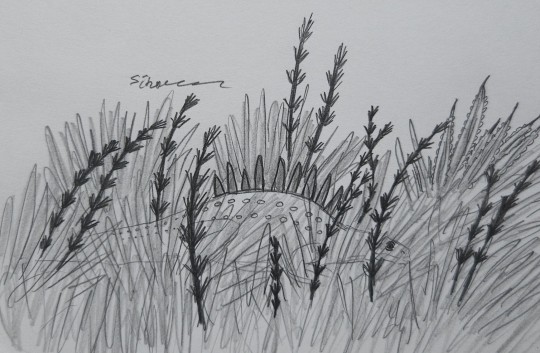
Croctober day 3:
Camouflage
7 notes
·
View notes
Text
Fossil Crocs of 2024
Another year another list of new fossil crocodilians that greatly expand our knowledge of Pseudosuchia across deep time. Happy to say that this is my third time doing this now, so I'm not going to bog you down with the details and get right into it.
Benggwigwishingasuchus
Our first entry, sorted by geological age of course, is Benggwigwishingasuchus eremicarminis (desert song fishing crocodile) from the Middle Triassic (Anisian) of Nevada. It was a member of the clade Poposauroidea, which some of you might recognize as also containing such bizarre early croc cousins like Arizonasaurus and Effigia. Also notable about Benggwigwishingasuchus is that it was found in the Fossil Hill Member of the Favret Formation. Why is that notable? Well the Fossil Hill Member preserves an environment deposited 10 km off the Triassic coastline and also yielded fossils of animals like Cymbospondylus, the giant ichthyosaur. Despite this however, Benggwigwishingasuchus shows no obvious signs of having been a swimmer or diver. Instead, its been hypothesized that it was simply foraging around the coast and might have been washed out to sea.
Artwork by Joschua Knüppe (@knuppitalism-with-ue) and Jorge A. Gonzalez
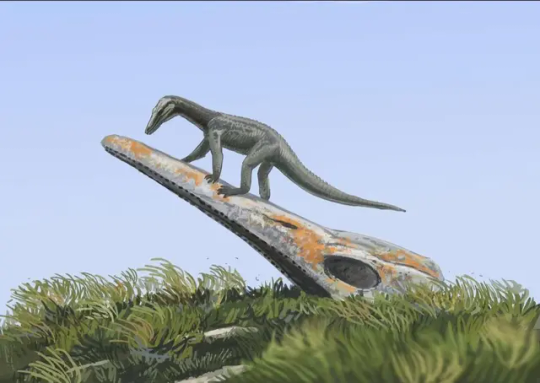
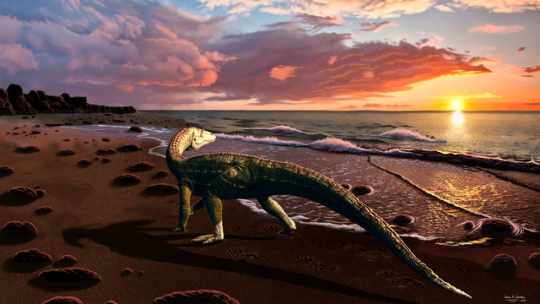
Parvosuchus
Fast forward some 5 million years to the Ladinian - Carnian of Brazil, specifically the Santa Maria Formation. Here you'll find the one new genus on the list I did not write the wikipedia page for: Parvosuchus aurelioi (Aurélio's Small Crocodile). With only a meter in length, Parvosuchus is amongst the smallest pseudosuchians of the year and a member of the aptly named Gracilisuchidae. Santa Maria was actually home to multiple pseudosuchians, including the mighty Prestosuchus (and its possible juvenile form Decuriasuchus), the small erpetosuchid Archeopelta and larger Pagosvenator and one more...
Artwork by Matheus Fernandes and Joschua Knüppe
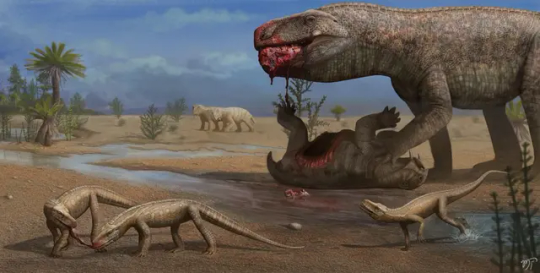

Schultzsuchus
Yup, Santa Maria has been eating good this year. Before the description of Parvosuchus, scientists coined the name Schultzsuchus loricatus (Schultz's Crocodile). Now this one's not entirely new and has long been known under the name Prestosuchus loricatus (by which I mean since 1938). What's interesting is that this new redescription suggests that rather than being a Loricatan, Schultzsuchus was actually an early member of Poposauroidea like Benggwigwishingasuchus. Even if it was no longer thought to be close to Prestosuchus, it was liekly still a formidable predator and among the larger pseudosuchians of the formation.
Artwork by Felipe Alves Elias

Garzapelta
Our last Triassic pseudosuchian and our only aetosaur of the year came to us in the form of Garzapelta muelleri (Mueller's Garza County Shield). It comes from the Late Triassic (Norian) Cooper Canyon Formation of, you guessed it, Garza County, Texas. As an aetosaur, the osteoderms are already regarded as diagnostic, tho unlike some other recent examples there is a little more material to go off from. It's still primarily osteoderms, but at least a good amount and even some ribs.
Artwork by Márcio L. Castro

Ophiussasuchus
Our only Jurassic newcommer is Ophiussasuchus paimogonectes (Paimogo Beach Swimmer Portuguese Crocodile), but arguably you couldn't find a better posterchild for Jurassic crocodyliforms. This new lad is a goniopholidid from the Kimmeridgian to Tithonian Lourinhã Formation, yup, Europe's Morrison. It's anatomy is perhaps not the most exciting, like other goniopholidids it had a flattened, very crocodilian-esque snout and was likely semi-aquatic like its relatives.
Artwork by @manusuchus and Joschua Knüppe


Enalioetes
Another quintessential group of Jurassic crocodyliforms are the metriorhynchoids, however, 2024's only new addition to this clade was actually Cretaceous, specifically from the earliest Cretaceous (Valanginian) of Germany. Like Schultzsuchus, Enalioetes schroederi (Schroeder's Sea Dweller) is new in name only, as fossil material has been found at the latest in 1918 and given the name Enaliosuchus "schroederi" in 1936. This kickstarted a whole series of taxonomic back and forth until the recent redescriptoin finally just gave it a new name and settled things (for now). Looking back I realize that I really need to take the time and fix up the Wikipedia page. Tho I've written its current status, I was kinda limited by being on vacation and never dived into the description section.
Artwork by Joschua Knüppe and Jackosaurus
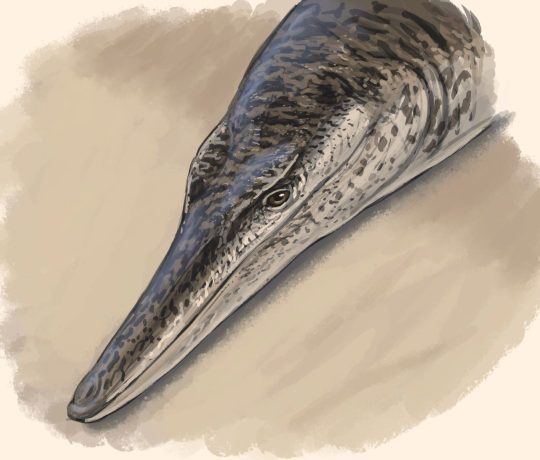

Varanosuchus
Another Early Cretaceous crocodyliform is Varanosuchus sakonnakhonensis (Monitor Lizard Crocodile from the Sakon Nakhon Province), described from Thailand's Sao Khua Formation. It lived around the same time as Enalioetes, but otherwise couldn't have been more different. Where Enalioetes was fully marine, Varanosuchus was more a land dweller as evidenced by the deep skull and long, slender legs. At the same time, some other features, like its more robust limbs compared to its kin, might suggest that Varanosuchus could have still spent some time in the water like some modern lizards. Tho one might be reminded of Parvosuchus from earlier, Varanosuchus is a much more recent example of small terrestrial croc-relatives, the atoposaurids, which are much closer to todays crocodiles and alligators.
Artwork once again by Manusuchus

Araripesuchus manzanensis
Yet another example of a small, gracile land "crocodile" comes to us in the form of Araripesuchus manzanensis (Araripe Basin Crocodile from the El Manzano Farm). And once again, it belonged to a completely different group, this time the notosuchian family Uruguaysuchidae. Now Araripesuchus is well known as a genus, in part due to the work of Paul Sereno and Hans Larsson (who popularized the names "dog croc" and "rat croc" for two species). Tangent aside, A. manzanensis is known from the upper layers of Argentina's Candeleros Formation, corresponding to the Cenomanian (earliest Late Cretaceous). The same locality also yielded A. buitreraensis, from which A. manzanensis can be distinguished on account of its blunt molariform teeth in the back of its jaw. This dentition, which corresponds to a durophageous diet of hardshelled prey, could explain how it coexisted with the related A. buitrensis at the same locality, allowing the two to occupy different niches. There is a neat little animation done for this animal you can watch here.
Artwork by Gabriel Diaz Yantén
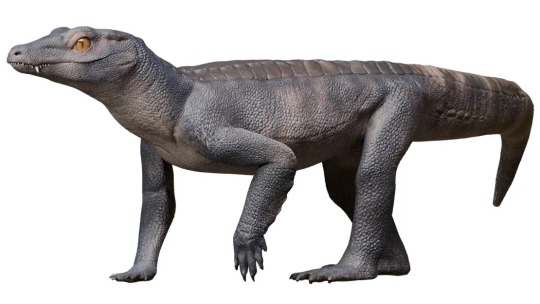
Caipirasuchus catanduvensis
We're staying in South America but moving to Brazil's Adamantina Formation for our next entry: Caipirasuchus catanduvensis (Caipiras Crocodile from Catanduva). This one is a little more recent, tho the age of the Adamantina Formation is a bit of a mess far as I can tell, ranging anywhere from the Turonian to the Maastrichtian. One could also argue that C. catanduvensis is part of the "lanky small croc club" that Parvosuchus, Varanosuchus and A. manzanensis belong to, but I feel that the very short snout helps it stand out from that bunch more easily. Anyhow, Caipirasuchus catanduvensis is a member of Sphagesauridae, related to Armadillosuchus, and herbivorous. What's really interesting tho is that the internal anatomy suggests the presence of resonance chambers not unlike that of hadrosaurs, possibly suggesting that these animals were quite vocal. This could also explain why baurusuchids appear to have had very keen hearing.
Artwork by Joschua Knüppe and Guilherme Gehr
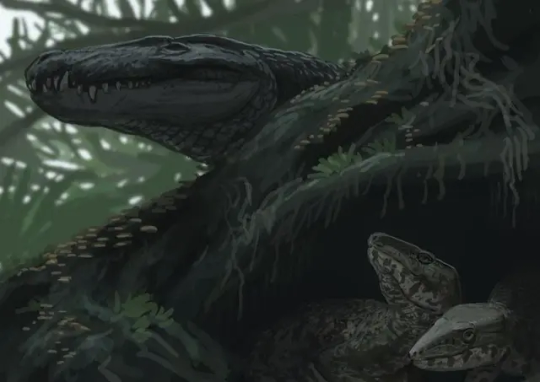

Epoidesuchus
We're staying in the Adamantina Formation for our last Mesozoic croc of the year, Epoidesuchus tavaresae (Tavares' Enchanted Crocodile). Tho also a Notosuchian like Araripesuchus and Caipirasuchus, this one belongs to the family Itasuchidae (or the subfamily Pepesuchinae depending on who you ask), which stand out as being rare examples of semi-aquatic members of this otherwise largely terrestrial group. Epoidesuchus was fairly large for its kin and had long, slender jaws. Like I said, Epoidesuchus and its relatives were likely more semi-aquatic than other notosuchians, something that might explain the relative lack of semi-aquatic neosuchians across Gondwana. They aren't absent mind you, but noticably rarer than they are in the northern hemisphere.
Artwork by Guilherme Gehr

And thus we move into the Cenozoic and towards the end our or little list. From here on out, say goodbye to Notosuchians or other weird crocodylomorphs and get ready for Crocodilia far as the eye can see.
Ahdeskatanka
The first Cenozoic croc we got is Ahdeskatanka russlanddeutsche (Russian-German Alligator), which despite its name comes from North Dakota, specifically the Early Eocene Golden Valley Formation. Ahdeskatanka is similar to many early alligatorines like Allognathosuchus in being small with rounded, globular teeth that suggest that it fed on hardshelled prey. This would have definitely helped avoid competition in the Golden Valley Formation, which also housed a second, similar form not yet named, a large generalist with a V-shaped snout similar to Borealosuchus and the generalized early caiman Chrysochampsa, also large but with a U-shaped snout.
Artwork by meeeeeeee

Asiatosuchus oenotriensis
We had an alligatoroid, so now its time for a crocodyloid. Asiatosuchus has been recognized from the Late Eocene Duero Basin of Spain for a while now, but now we have a name: Asiatosuchus oenotriensis (Asian Crocodile Belonging To The Land Of Wine). Asiatosuchus is a complex genus, most often not really forming a monophyletic clade and likely representing several distinct or at least successive taxa that form the "Asiatosuchus-like complex". Within this complex, A. oenotriensis is thought to have been close-ish to Germany's Asiatosuchus germanicus.
Artwork by Manusuchus

Sutekhsuchus
Rounding out the trio of major crocodilian clades is Sutekhsuchus dowsoni (Set's Crocodile/God of Deception Crocodile), representing our only gavialoid of the year. Originally described as Tomistoma dowsoni in 1920 based on fossil remains from the Miocene of Egypt, Sutekhsuchus has been at times regarded as distinct and at other times lumped into Tomistoma lusitanica. It was one of several early gavialoids to inhabit the coast of the Tethys during the Miocene and appears to have been most closely related to the genus Eogavialis, clading together just outside of the American and Asian gharials. A fun little personal anecdote, I prematurely learned about this one due to a friend highlighting the name in a study on Eogavialis. Never having heard of "Sutekhsuchus" I took to google scholar, where I found a single result: a reference to the then unpublished description, which naturally I ended up eagerly awaiting.
Artwork by Manusuchus and Joschua Knüppe
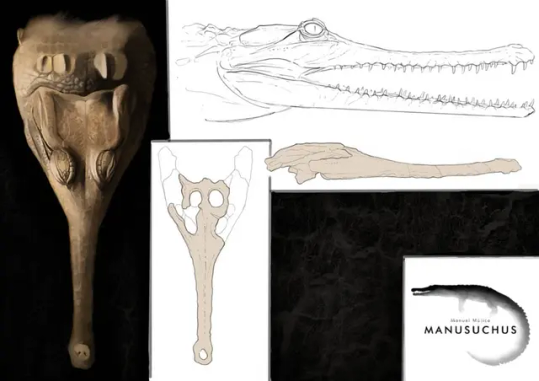
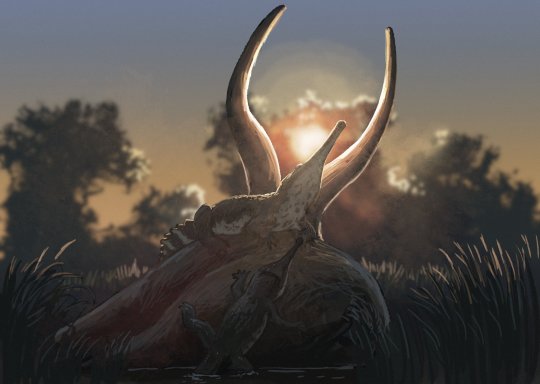
Paranacaiman
Two more and we're done. First, completely arbitrarily, Paranacaiman bravardi (Bravard's Caiman from Parana) from the Miocene Ituzaingo Formation of Argentina. Material of this genus has originally been referred to Caiman lutescens, described in 1912 but now considered a nomen dubium. Paranacaiman is known from limited material only, just the skull table, but that would indicate a "huge" animal. My personal scaling recovered a size of almost 5 meters in length, similar to large black caimans today.
Once again, credit to me

Paranasuchus
Last but not least, Paranasuchus gasparinae (Gasparini's Crocodile from Parana). Coming from the same deposits as Paranacaiman, this one too has been known as a species of Caiman for some time before being assigned its own genus, though it at least got to retain its old species name. Alas, I have not scaled it myself, tho its material is at least more extensive than that of Paranacaiman, including even parts of the snout. A little nitpick because I don't have much to say, but I personally think the name was ill conceived. On its own both Paranacaiman and Paranasuchus are fine names don't get me wrong, but together, coined by the same authors in the same study no less, they strike me as needlessly confusing to non experts. Both are caimans, both are from Parana, so the distinction between "Parana Caiman" and "Parana Crocodile" is entirely arbitrary and doesn't really distinguish them. Not helped by the fact that they are even closely related in the original description. Other than that tho another good addition to our understanding of fossil crocs.
No artwork on this one, but fossil material from Bona et al. 2024

And that wraps up 2024. I hope This post, or my posts throughout the year or even my work on Wikipedia has helped to make these fascinating animals just a little bit more approachable and a massive thanks to all the artists who took their time to create fantastic pieces featuring these incredible animals. Special shout outs to Manusuchus, who diligently illustrated a lot of the featured animals and Joschua Knüppe, who had to listen to me suggest Ahdeskatanka every Sunday for about two months straight now.
Fossil Crocs of 2023
Fossil Crocs of 2022
#paranasuchus#paranacaiman#ahdeskatanka#sutekhsuchus#ophiussasuchus#epoidesuchus#caipirasuchus#araripesuchus#enalioetes#parvosuchus#benggwigwishingasuchus#schultzsuchus#garzapelta#varanosuchus#paleontology#prehistory#palaeoblr#long post#fossil crocs of 2024#paleo#paleonotlogy#crocodilia#crocodylomorpha#pseudosuchia#fossils#2024
234 notes
·
View notes
Photo




Once again it's a PBS Eons commission roundup day!
An unnamed Cerro Ballena rorqual whale and the long-necked seal Acrophoca, from "How the Andes Mountains Might Have Killed a Bunch of Whales" https://www.youtube.com/watch?v=iNk6r5WljGc
The poposauroid pseudosuchians Shuvosaurus (life restoration) and Effigia (skeletal) from "When Dinosaur Look-Alikes Ruled the Earth" https://www.youtube.com/watch?v=QsmV34Co32c
———
Nix Illustration | Tumblr | Pillowfort | Twitter | Patreon
#science illustration#paleontology#paleoart#palaeoblr#pbs eons#cerro ballena#rorqual#mysticeti#baleen whale#cetacean#acrophoca#phocidae#seal#pinniped#marine mammal#mammal#shuvosaurus#effigia#poposauroidea#rauisuchia#pseudosuchia#croc-line archosaurs#stem-croc#archosaur#art#commissioned work
157 notes
·
View notes
Text
Effigia okeeffeae

By Stolpergeist
Etymology: Ghost
First Described By: Nesbitt and Norell, 2006
Classification: Biota, Archaea, Proteoarchaeota, Asgardarchaeota, Eukaryota, Neokaryota, Scotokaryota Opimoda, Podiata, Amorphea, Obazoa, Opisthokonta, Holozoa, Filozoa, Choanozoa, Animalia, Eumetazoa, Parahoxozoa, Bilateria, Nephrozoa, Deuterostomia, Chordata, Olfactores, Vertebrata, Craniata, Gnathostomata, Eugnathostomata, Osteichthyes, Sarcopterygii, Rhipidistia, Tetrapodomorpha, Eotetrapodiformes, Elpistostegalia, Stegocephalia, Tetrapoda, Reptiliomorpha, Amniota, Sauropsida, Eureptilia, Romeriida, Disapsida, Neodiapsida, Sauria, Archosauromorpha, Crocopoda, Archosauriformes, Eucrocopoda, Archosauria, Pseudosuchia, Suchia, Paracrocodylomorpha, Poposauroidea, Shuvosauridae
Referred Species: E. okeeffeae
Status: Extinct
Time and Place: Around 205 million years ago, in the Rhaetian of the Late Triassic
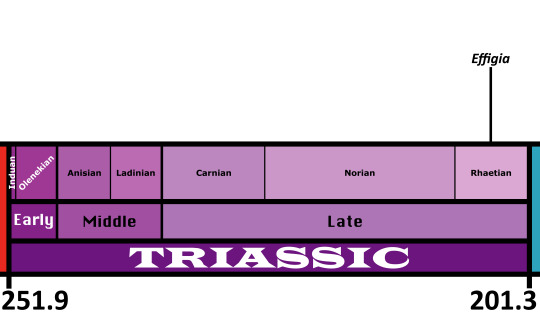
Effigia was found at Ghost Ranch in the Chinle Formation in New Mexico
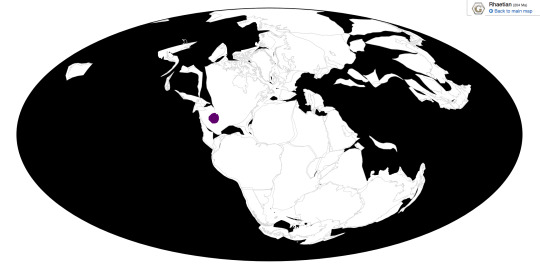
Physical Description: Effigia was a small, bipedal animal that remarkably resembled dinosaurs it lived with at the time. In total, from head to tail, it would have been about two meters long. It walked on two legs that were held directly underneath the body, and it had small arms that weren’t used in supporting its weight. It had a long body, with a decently sized tail and long neck. The head of Effigia was small and narrow, ending in a beak and having no teeth whatsoever. So, in short, it looked like the later Limusaurus, except it wasn’t feathered - and it wasn’t a dinosaur! This is the first known example of the lightly-built bipedal animal with a beak body plan, aka, the “ostrich” body plan, even though this iteration - the first iteration - had nothing resembling feathers or efficient breathing or hollow bones. In fact, it probably would have breathed primarily based on abdominal muscles, based on its close relatives. And it did have hollow bone walls, much like dinosaurs. Effigia also had a somewhat endothermic body temp - ie, it was closer to warm-bloodedness than modern crocodilians, and may have even been warm-blooded outright. It had five fingers on each hand, though only three of each would have claws; it had four main toes on each foot, unlike the three in theropods, and a little toe raised up (kind of like the fourth toe in theropods). It was rather front heavy, unlike theropods that lean more towards the hip, giving it a forward-leaning appearance.
Diet: Probably herbivorous. While the exact diet of Effigia is murky, the beak of this species indicates it probably would have fed on a variety of plant material, like the later mimics such as Limusaurus and Ornithomimus. However, omnivory was certainly not out of the question.
Behavior: Because Effigia was front-titled, it’s actually not clear whether or not it would have behaved similarly to the animals it resembles. In fact, it doesn’t seem very well adapted for fast movement at all - it looks exactly like the sort of creature that may have tripped over itself on a regular basis. That said, it is entirely possible that it would have balanced itself differently, or adjusted its position in such a way to make up for this oddity in posture. That said, it also had fairly short legs compared to its overall body length, so it’s doubtful that it would have been a fast mover in any position. As such, it probably would have moved slowly throughout its ecosystem, grazing on plants and following fresh vegetation where it came up and utilizing its long neck to reach into areas where food was less accessible, and grabbing on to it for feeding. It may not have been a particularly social animal though, like living archosaurs, it probably would have taken care of its young in some fashion.
Ecosystem: Ghost Ranch was a large floodplain, not quite as forested as the environment had been in earlier times (when they were literally called the “petrified forest”), however, there were still extensive dry forests that experienced dramatic dry and wet seasons each year. These seasons were interspersed with regular flooding, which lead to rapid preservation of a very diverse Late Triassic ecosystem. This was an extremely diverse habitat, with a variety of other reptiles that lived alongside Effigia. There was the slender dinosaur Coelophysis, the weirdly-toothed dinosaur Daemonosaurus, the Silesaurids Kawanasaurus and Eucoelophysis, the Lagerpetid Dromomeron, the early Crocodylomorph Hesperosuchus, the Aetosaur Stenomyti, the phytosaur Redondasaurus, the Drepanosaurs Avicranium and Drepanosaurus, the aquatic archosauriform Vancleavea, the sphenodont Whitakersaurus; coelocanths, ray-finned fish, mystery fish, and even invertebrates such as branchiopods and ostracods. It’s possible that Effigia lived alongside other animals as well, but more research is needed into the exact environment of the Chinle Formation where Effigia was found before that can be confirmed. It is entirely possible that Effigia would have been preyed upon by Coelophysis.
Other: Effigia is so freaking weird, you guys. Like, the Triassic may as well be called the Period in Which Reptiles Tried Out All The Things Dinosaurs Would Later Do (But Only Dinosaurs Would Get Paid For It). It is so similar to later Ornithomimosaurs that at least a few paleontologists used to think that the remains later called Effigia were actually dinosaurs, before their proper reassignment into the Pseudosuchians. This just emphasizes how much different reptiles were trying out new designs and new ideas in the Triassic Period, some of which superficially resembled later dinosaurs - but with surprise twists. It also demonstrates exactly how much crocodile-relatives were diversifying extensively in the Triassic, and how hard they would be hit by the end-Triassic extinction.
~ By Meig Dickson
Sources Under the Cut
Colbert, E. H.. 1947. The little dinosaurs of Ghost Ranch. Natural History 59(9):392-399-427-428.
Heckert, A. B., S. G. Lucas, L. F. Rinehart and A. P. Hunt. 2008. A new genus and species of sphenodontian from the Ghost Ranch Coelophysis Quarry (Upper Triassic: Apachean), Rock Point Formation, New Mexico, USA. Palaeontology 51(4):827-845.
Hunt, A. P., and A. G. Lucas. 1989. Late Triassic vertebrate localities in New Mexico. In S. G. Lucas and A. P. Hunt (eds.), Dawn of the Age of Dinosaurs in the American Southwest, New Mexico Museum of Natural History, Albuquerque 72-101.
Hunt, A. P., and S. G. Lucas. 1993. A new phytosaur (Reptilia: Archosauria) genus from the uppermost Triassic of the western United States and its biochonological significance. In S. G. Lucas and M. Morales (eds.), The Nonmarine Triassic. New Mexico Museum of Natural History and Science Bulletin 3:193-196.
Lucas, S. G., J. A. Spielmann, A. P. Hunt. 2007. Taxonomy of Shuvosaurus, a Late Triassic archosaur from the Chinle Group, American Southwest. New Mexico Museum of Natural History and Science Bulletin 41: 259 - 261.
Lucas, S. G., J. A. Spielmann, and L. F. Rinehart. 2013. Juvenile skull of the phytosaur Redondasaurus from the Upper Triassic of New Mexico, and phytosaur ontogeny. New Mexico Museum of Natural History and Science Bulletin 61:389-400.
Martz, J. W., B. J. Small. 2019. Non-dinosaurian dinosauromorphs from the Chinle Formation (Upper Triassic) of the Eagle Basin, northern Colorado: Dromomeron romeri (Lagerpetidae) and a new taxon, Kwanasaurus williamparkeri (Silesauridae). PeerJ 7: e7551.
Nesbitt, S., M. A. Norell. 2006. Extreme convergence in the body plans of an early suchian (Archosauria) and ornithomimid dinosaurs (Theropoda). Proceedings of the Royal Society B: Biological Sciences 273 (1590): 1045-1048.
Nesbitt, S. 2007. The anatomy of Effigia okeeffeae (Archosauria, Suchia), theropod-like convergence, and the distribution of related taxa. Bulletin of the American Museum of Natural History 302: 84.
Nesbitt, S. J., M. R. Stocker, B. J. Small and A. Downs. 2009. The osteology and relationships of Vancleavea campi (Reptilia: Archosauriformes). Zoological Journal of the Linnean Society 157:814-864.
Nesbitt, S. 2011. The Early Evolution of Archosaurs: Relationships and the Origin of Major Clades. Bulletin of the American Museum of Natural History 352: 1 - 292.
Pritchard, A. C., and S. J. Nesbitt. 2017. A bird-like skull in a Triassic diapsid reptile increases heterogeneity of the morphological and phylogenetic radiation of Diapsida. Royal Society Open Science 4:170499.
Renesto, S., J. A. Spielmann, S. G. Lucas and G. T. Spagnoli. 2010. The taxonomy and paleobiology of the Late Triassic (Carnian-Norian: Adamanian-Apachean) drepanosaurs (Diapsida: Archosauromorpha: Drepanosauromorpha). New Mexico Museum of Natural History and Science, Bulletin 46:1-81.
Rinehart, L. F., S. G. Lucas, A. B. Heckert, J. A. Spielmann, and M. D. Celeskey. 2009. The paleobiology of Coelophysis bauri (Cope) from the Upper Triassic (Apachean) Whitaker quarry, New Mexico, with detailed analysis of a single quarry block. New Mexico Museum of Natural History and Science Bulletin 45:1-260.
Schachner, E. R., P. L. Manning, P. Dodson. 2011. Pelvic and hindlimb myology of the basal archosaur Poposaurus gracilis (archosauria: Poposauroidea). Journal of MOrphology 272 (12): 1464 - 1491.
Schaeffer, B. 1967. Late Triassic fishes from the western United States. Bulletin of the American Museum of Natural History 135(6):285-342.
Sues, H.-D., S. J. Nesbitt, D. S. Berman and A. C. Henrici. 2011. A late-surviving basal theropod dinosaur from the latest Triassic of North America. Proceedings of the Royal Society B 278:3459-3464.
#Effigia#Effigia okeeffeae#Poposaur#Pseudosuchian#Triassic#Archosaur#Reptile#Triassic Madness#Palaeoblr#Triassic March Madness#Prehistoric Life#Paleontology#Prehistory
198 notes
·
View notes